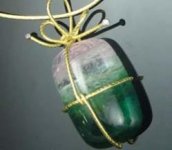SteveM
Well-known member
- Joined
- Jan 29, 2007
- Messages
- 1,928
This thread continues a personal voyage, trusting that others are traveling similar roads and will also share their experiences.
In Natural Combinations my interests in poe pipi from the Cook Islands and paua pearls from New Zealand were bridged, resulting in the natural pearl pin that serves most frequently as my avatar. Recently, during a pregnant pause in the Nautilus Pearl thread, Ammolite Ammonites from Alberta (ammonites being a direct ancestor of the Nautilus) came forcefully to my attention. Turns out ammolite is the world’s rarest precious gem—and organic to boot, along with only pearls and amber. In fact, ammolite is fossilized/mineralized/geologically-compressed nacreous shell: ’’Super Nacre” (to a certified NCN, a natural progression!).
Ammolite as well as Opal are products of mineral sedimentation in ancient inland seas of the Cretaceous period (70 million years ago). They share much in common, notably iridescence/opalescence and difficult separation from matrix. Processing is similar, and finding authentic examples correctly produced by craftsmen vs. commercially available doublets, triplets, etc. is NOT easy. Happily, I have recently acquired a couple of superb 100% gem examples from such an artisan.
Valeria101 suggested a design affinity between abalone pearls and ammolite. The leap to opal and abalone is my own.
The left three images below are the same two subjects, conceived as a two-sided pendant. The ammolite (27mm x 17mm) has an intense green/blue/orange side, and a back side that is primarily red/orange and/or green/orange. The abalone pearl is a quite unusual roundish baroque of good size, with excellent lustre.
The image on the right is boulder opal with a California ab with significant smooth color surface. Since the opal is cut as a cabochon and the ab has a darkish understated back side, this would be a one-sided pendant.
In Natural Combinations my interests in poe pipi from the Cook Islands and paua pearls from New Zealand were bridged, resulting in the natural pearl pin that serves most frequently as my avatar. Recently, during a pregnant pause in the Nautilus Pearl thread, Ammolite Ammonites from Alberta (ammonites being a direct ancestor of the Nautilus) came forcefully to my attention. Turns out ammolite is the world’s rarest precious gem—and organic to boot, along with only pearls and amber. In fact, ammolite is fossilized/mineralized/geologically-compressed nacreous shell: ’’Super Nacre” (to a certified NCN, a natural progression!).
Ammolite as well as Opal are products of mineral sedimentation in ancient inland seas of the Cretaceous period (70 million years ago). They share much in common, notably iridescence/opalescence and difficult separation from matrix. Processing is similar, and finding authentic examples correctly produced by craftsmen vs. commercially available doublets, triplets, etc. is NOT easy. Happily, I have recently acquired a couple of superb 100% gem examples from such an artisan.
Valeria101 suggested a design affinity between abalone pearls and ammolite. The leap to opal and abalone is my own.
The left three images below are the same two subjects, conceived as a two-sided pendant. The ammolite (27mm x 17mm) has an intense green/blue/orange side, and a back side that is primarily red/orange and/or green/orange. The abalone pearl is a quite unusual roundish baroque of good size, with excellent lustre.
The image on the right is boulder opal with a California ab with significant smooth color surface. Since the opal is cut as a cabochon and the ab has a darkish understated back side, this would be a one-sided pendant.
Attachments
Last edited:



